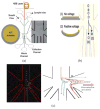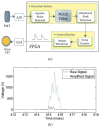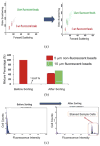Human mammalian cell sorting using a highly integrated micro-fabricated fluorescence-activated cell sorter (microFACS)
- PMID: 20379604
- PMCID: PMC3118392
- DOI: 10.1039/c000136h
Human mammalian cell sorting using a highly integrated micro-fabricated fluorescence-activated cell sorter (microFACS)
Abstract
We demonstrate a high performance microfabricated FACS system with highly integrated microfluidics, optics, acoustics, and electronics. Single cell manipulation at a high speed is made possible by the fast response time (approximately 0.1 ms) of the integrated PZT actuator and the nozzle structure at the sorting junction. A Teflon AF-coated optofluidic waveguide along the microfluidic channel guides the illumination light, enabling multi-spot detection, while a novel space-time coding technology enhances the detection sensitivity of the microFACS system. The real-time control loop system is implemented using a field-programmable-gate-array (FPGA) for automated and accurate sorting. The microFACS achieves a high purification enrichment factor: up to approximately 230 fold for both polystyrene microbeads and suspended human mammalian cells (K562) at a high throughput (>1000 cells s(-1)). The sorting mechanism is independent of cell properties such as size, density, and shape, thus the presented system can be applied to sort out any pure sub-populations. This new lab-on-a-chip FACS system, therefore, holds promise to revolutionize microfluidic cytometers to meet cost, size, and performance goals.
Figures






References
Publication types
MeSH terms
Grants and funding
LinkOut - more resources
Full Text Sources
Other Literature Sources
Miscellaneous

